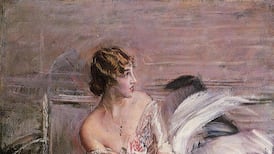Asked to speak at last Monday’s launch of a new edition of James Joyce’s story for children, The Cat and the Devil, I thought I might begin by mentioning the phone-call I once received from the man for whom it was originally written: his grandson Stephen.
Then I might explain why, although the story is set in a French town, the mayor is named Alfie Byrne.
After that, I would contrast the simplicity of the narrative with the other thing Joyce was working on in 1936: a dense, multilingual maze that is still being deciphered by PhD students today.
But while I was jotting down these notes, it belatedly occurred to me to check who exactly would be attending the launch, apart from some schoolchildren mentioned in correspondence. That’s when I realised my audience would be comprised exclusively of six- and seven-year-olds. At which point, I crossed out the bit about Finnegans Wake, and most of the rest of my notes.
The Beaugency where Joyce set his story is a real place on the river Loire, near Orléans, and has long been noted mainly for the magnificent stone bridge that is central to the tale. Joyce stayed in the town during his summer holidays of 1936, writing the story shortly afterwards in the form of a letter to Stephen, then aged four-and-a-half.
It was a version of the local folk tale explaining how the great 26-arch bridge first came to be built in the 13th century. Lacking money to do it themselves, the townspeople opted for that medieval forerunner of the public-private partnership: a deal with the Devil. The arch-fiend (in every sense) agreed to build it overnight, and for a very reasonable cost: possession of the first soul to cross it.
Thus, the bridge appeared one morning, with the Devil waiting at the far end. But of course, no townsperson wanted to be the one who paid the toll.
Instead, the canny mayor who had negotiated the deal, “Monsieur Alfred Byrne”, arrived with a bucket of water in one hand and a cat in the other. Applying the former to the latter, suddenly, he impelled the cat (and his soul) to cross the bridge at speed, leaving the devil to curse the locals in what Joyce suggests was a “strong Dublin accent”.
Whoever really built it, the bridge was important enough to be fought over repeatedly during the 100 Years War that soon followed. In the Battle of Beaugency (1429), the Maid of Orléans herself liberated it from the English. And that event explains another of its appearances in fiction, via Mark Twain’s strange 1896 novel, Personal Recollections of Joan of Arc, by the Sieur Louis de Conte.
The book is all but forgotten today, for good reason. It’s a serious novel, nothing like Twain’s usual style. And having spent many years researching the subject, he thought it his best work. But not many modern readers agree. His earnest historical account of how St Joan saved the bridge is now less popular than Joyce’s account of how the Devil built it.
In later years, Stephen would marvel at how “Nonno” (as Joyce Snr signed the letter) took time out from his ever-more-complex novels to write stories for him, in language a four-year-old could understand. Stephen’s mother had equally marvelled, once, at the patience with which the writer used to answer the endless “grave little questions” his grandson always asked when they met.
I gained an unexpected insight into their relationship at the Museum of Literature Ireland on Monday when, after reading the book to the tiny pupils of St Brigid's School, from the nearby Coombe, we invited questions from the audience. The number and range of points raised were bewildering. Finnegans Wake was one of the few topics not to feature.
I did, however, get to tell them my story of the phone call from Stephen. It was in 2003, when the former four-year-old was nearer 74, although still asking little questions in a grave voice, in this case: "Am I speaking to Frank McNally?" Then he said: "My name is Stephen Joyce, grandson of James Joyce".
Those were among the most stress-inducing words in English then, especially if you were a publisher. But just as I was wondering what breach of copyright I had committed, he said he was calling only to say that he had read and enjoyed a joke I had recently written about his grandfather, and he thought Joyce himself would have enjoyed it too.
He could speak with some authority on the latter point, he added, because he still conversed with the old man regularly, when visiting his grave in Zurich.












